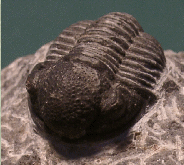|
The Order PROETIDA (Fortey, Owens, 1975) The Proetida was first seperated from the Order Ptychopariida at 1975 as a self- sufficiant Order. The representatives of the Proetida are to be about low- growing and compact trilobites. Species of the Proetida solely survived up to Permian until their extiction around Permians end (Oberes Zechstein). The Proetida are covering the Superfamilies Proetoidea, Aulacopleuroidea and Bathyuroidea. The image shows a representative of the Superfamily Proetoidea.
|
 Proetus sp. |
|
Epoch Lower Ordovician to Upper Permian. The cephalon is typically developed parabolic (exception- Aulacopleuroidea) and has genal spines. The big glabella is anterior tapering. There are typically 4 pairs of glabellar furrows. The sutures are normally running ophistoparian (Gr.- cheek). The Proetida are featuring a natant hypostome ordinary grown (filter feeders). During their evolution, some species developed the conterminant type (predators). As a rule, the Proetida have great schizochroal eyes.
The thorax is divided into 8- 22 segments. The pleural tips can be developed from dull to tapered.
The development of the pygidium ranges from micropygous (Gr.- small) to subisopygous i. e. the pygidium is much smallish and smallish respectively developed than the cephalon. Sometimes the pygidium has spines.
|
|